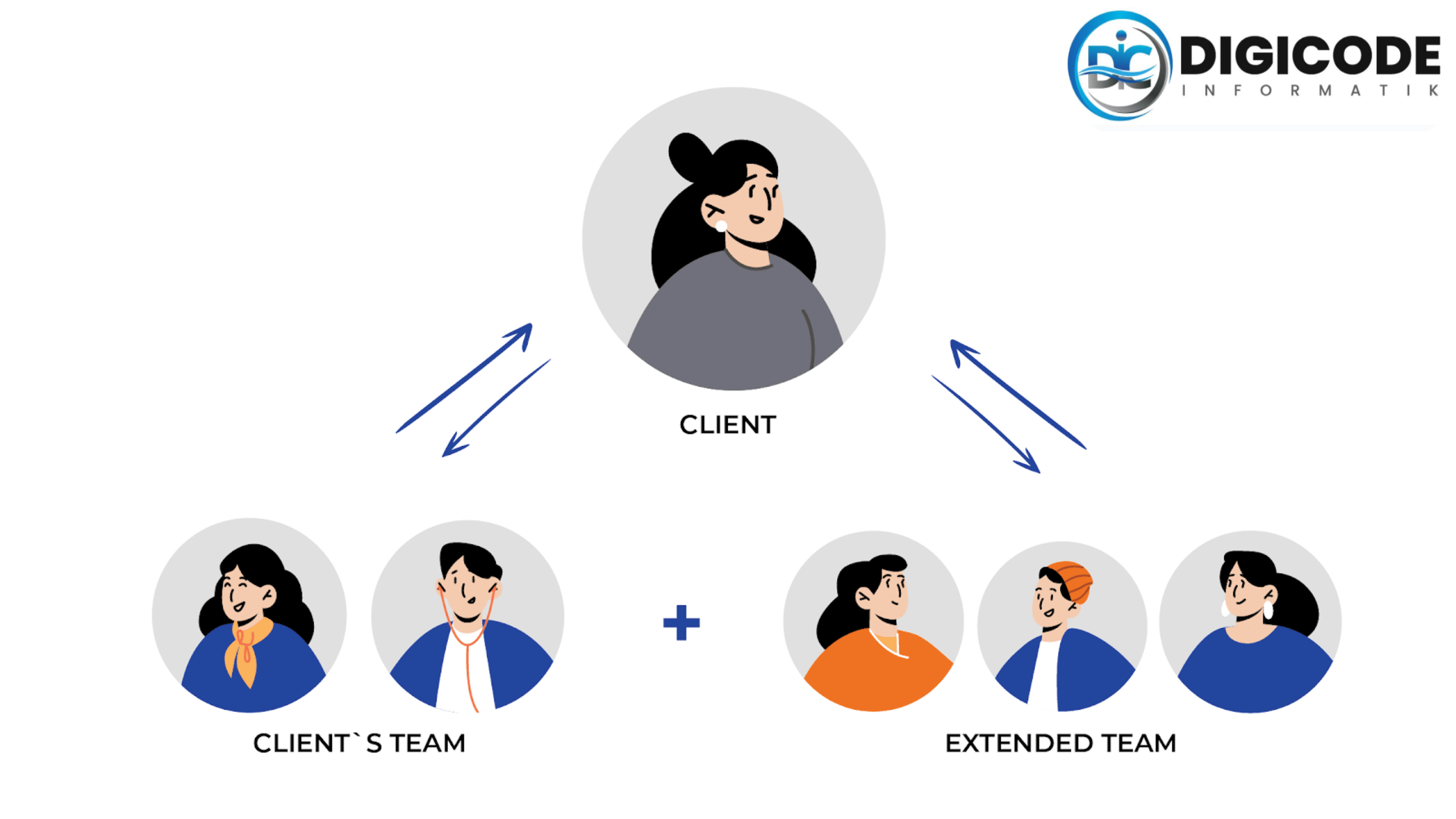Outstaffing and outsourcing are two business models that allow companies to access external talent and expertise without incurring the costs of hiring full-time employees. While these models may seem similar, there are important differences that can impact a company's decision on which approach to take. In this article, we'll explore the key differences between outstaffing and outsourcing, their pros and cons, and which approach may be best suited for different business needs.
What is Outstaffing?
Outstaffing is a business model in which a company hires staff members through an intermediary company or service provider, who then become employees of the outsourcing company. In outstaffing, the staff members work exclusively for the outsourcing company, but are not physically present in its offices. Instead, they work remotely, either from their own locations or from a shared office space provided by the intermediary company.
Outstaffing is often used by companies looking to access a specialized talent pool, without having to invest in the infrastructure and resources necessary to recruit and train in-house staff. It is particularly popular in the IT industry, where companies may need access to specialized skills or technologies, but may not have the resources to hire and train staff in-house.
Under an outstaffing model, the outsourcing company retains control over the work performed by the outstaffed employees, including the scope of work, deadlines, and quality standards. However, the intermediary company takes care of administrative tasks such as payroll, taxes, benefits, and legal compliance.
Outstaffing is sometimes confused with outsourcing, but there are important differences between the two. In outsourcing, the service provider is responsible for the delivery of a specific service or project, which may or may not involve the use of its own employees. In outstaffing, the outsourcing company hires its own employees, who are managed and controlled by the intermediary company.
Overall, outstaffing can be a useful model for companies looking to access specialized talent or resources, while minimizing the costs and risks associated with in-house recruitment and training. However, it is important to choose a reputable intermediary company with a track record of success, and to establish clear communication and expectations with the outstaffed employees.
What is Outsourcing?
Outsourcing is a business model in which a company hires an external service provider to perform a specific business function or task that would otherwise be performed in-house. The service provider may be located locally or abroad and is responsible for delivering the agreed-upon service or project.
Outsourcing is a common practice in a wide range of industries and functions, including IT, customer service, accounting, manufacturing, and marketing. The benefits of outsourcing include access to specialized expertise, cost savings, increased efficiency, and the ability to focus on core business functions.
There are several types of outsourcing, including:
Offshore outsourcing: This refers to outsourcing to service providers in another country, often to take advantage of lower labor costs.
Nearshore outsourcing: This refers to outsourcing to service providers in a neighboring country, often to take advantage of similar time zones, cultural similarities, and lower labor costs.
Onshore outsourcing: This refers to outsourcing to service providers within the same country as the outsourcing company, often to take advantage of lower labor costs in different regions or to access specialized expertise.
Outsourcing can also be categorized based on the type of service provided. Some common examples of outsourced services include:
IT outsourcing: This involves outsourcing IT functions such as software development, network administration, and helpdesk support.
Business process outsourcing (BPO): This involves outsourcing non-core business functions such as customer service, accounting, and human resources.
Manufacturing outsourcing: This involves outsourcing the manufacturing of products to external suppliers, often to take advantage of lower labor and production costs.
While outsourcing can offer many benefits, it is not without its challenges. Outsourcing can result in loss of control over the outsourced functions, communication challenges, and quality control issues. It is important to carefully select outsourcing partners, establish clear expectations and communication channels, and monitor performance regularly to ensure success.
Key Differences between Outstaffing and Outsourcing:
While outstaffing and outsourcing are both ways for companies to access specialized talent and resources, there are several key differences between the two models. Here are some of the main differences:
1. Employment status: In outstaffing, the intermediary company is responsible for hiring the employees and making them available to the outsourcing company. The employees are typically considered full-time employees of the intermediary company, while in outsourcing, the service provider is responsible for delivering a specific service or project to the outsourcing company, and the employees may or may not be full-time employees of the service provider.
2. Control over employees: In outstaffing, the outsourcing company has more control over the outstaffed employees, as they are typically managed directly by the outsourcing company. In outsourcing, the service provider has more control over the employees and how they perform their work.
3. Work location: In outstaffing, the employees are often remote workers, either working from home or from a shared office space provided by the intermediary company. In outsourcing, the work may be performed on-site at the service provider's location or remotely.
4. Payment structure: In outstaffing, the intermediary company is responsible for paying the employees and providing benefits such as insurance and vacation time. In outsourcing, the service provider is responsible for all costs associated with delivering the service or project, and the outsourcing company pays for the services rendered.
5. Type of work: Outstaffing is typically used for more specialized or ongoing work, such as software development or IT support, while outsourcing is often used for specific projects or tasks, such as website development or customer service.
Control: With outstaffing, the client company retains full control over the project and the outstaffing partner becomes an extension of the client's internal team. With outsourcing, the client has less control over the project, as the outsourcing partner takes full responsibility for the work.
Flexibility: Outstaffing provides more flexibility for the client company, as the outstaffing partner can be scaled up or down as needed. Outsourcing is typically a fixed-term engagement and may not be as flexible.
Expertise: Outstaffing provides access to highly specialized skills and expertise, as the outstaffing partner is often hired for their specific skillset. With outsourcing, the client may not have as much input into the specific expertise of the team members assigned to their project.
Cost: Outstaffing may be more cost-effective for the client, as they only pay for the services of the outstaffing partner and do not need to cover additional overhead costs. Outsourcing may be more expensive, as the client is paying for the full service delivery from the outsourcing partner.
Pros:
Outstaffing :
1. Access to specialized talent and expertise without the need to hire and manage employees directly.
2. Greater control over the work performed by the outstaffed employees.
3. Flexibility to adjust the size and composition of the team as needed.
4. Cost savings on benefits, insurance, and other employee-related expenses.
5. Reduced administrative burden compared to hiring and managing employees in-house.
Outsourcing:
1. Access to specialized talent and expertise without the need to hire and train employees in-house.
2. Lower costs compared to outstaffing, as the service provider is responsible for all employee-related expenses.
3. Flexibility to scale up or down as needed for specific projects or tasks.
4. Reduced administrative burden compared to managing employees in-house.
Cons:
Outstaffing:
1. Higher costs compared to outsourcing, as the intermediary company charges a markup on the salaries of the outstaffed employees.
2. Greater responsibility for managing and coordinating the work of the outstaffed employees.
3. May be less suitable for short-term or project-based work.
4. Potential for communication challenges and cultural differences with remote workers.
Outsourcing:
1. Less control over the work performed by the service provider and its employees.
2. Potential for communication challenges and quality control issues with remote service providers.
3. Potential for service providers to cut corners or deliver subpar work in order to save costs.
4. Potential for intellectual property and confidentiality issues if sensitive information is shared with the service provider.
In conclusion, both outstaffing and outsourcing have their own advantages and disadvantages, and the decision to choose one over the other will depend on the specific business needs and goals. Outstaffing offers greater control over the outstaffed employees and is typically used for more specialized or ongoing work, while outsourcing offers lower costs and more flexibility for project-based work, but with less control over the service provider and its employees. It is important for businesses to carefully evaluate the pros and cons of each approach and choose the one that best fits their needs in terms of talent, expertise, cost, flexibility, and control.




